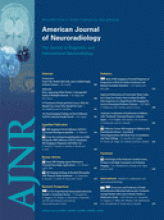We read the interesting report by Dai et al,1 wherein the authors examined histology at the basilar terminus (BT) following right common carotid artery (RCCA) ligation as a part of a procedure to create an elastase aneurysm model in 30 consecutive New Zealand white rabbits at various time points. The authors concluded that in contrast to our previous report,2 there was no bulgelike localized dilation associated with a missing internal elastic lamina (IEL) to suggest microaneurysm or nascent aneurysm formation at the BT, at any time point after RCCA ligation.
We find this report particularly interesting because the first aneurysmal changes at the rabbit BT that we noticed actually occurred in 2 rabbits that had undergone RCCA ligation.3 The rabbits underwent the same surgical procedure as that performed by Dai et al,1 with the same objective of creating the elastase aneurysm model on the RCCA stump for an endovascular device testing.3 We examined whether there were any aneurysmal changes in the basilar bifurcation in these 2 rabbits through histologic staining of contiguous specimens with hematoxylin-eosin (HE), Van Gieson, and trichrome. In the first rabbit, sacrificed 10 weeks after RCCA ligation, we observed loss of IEL, endothelial cells, and smooth muscle cells, a thinned media, and an outward convex bulge at the BT (Fig 1). Fifteen consecutive sections of 15-μm thickness consistently presented this BT bulge with missing IEL and media thinning. We repeated the observation in the second rabbit, which had received incomplete RCCA ligation and was sacrificed 12 weeks later. We saw similar aneurysmal changes, including IEL loss and medial thinning at the BT, albeit with a shallower and longer bulge (Fig 2). These vascular defects were clearly aneurysmal and could not be a staining or sectioning artifact, or misinterpreted branches.
An aneurysm detected at the rabbit BT 10 weeks after RCCA ligation in an elastase aneurysm model. A, Basilar artery−posterior cerebral artery bifurcation shown at a low magnification. Arrow indicates blood flow direction. An aneurysm is observed between a and b, with IEL disruption (a total length of 300 μm) and media thinning occurring in the bulge (Van Gieson, original magnification ×100). B−D, The aneurysm site is shown at a high magnification (original magnification ×400). B, Van Gieson staining shows IEL loss. C, HE staining shows endothelial loss. D, Trichrome staining shows medial thinning.
Aneurysmal degradation at the rabbit BT 12 weeks after incomplete RCCA ligation in an elastase aneurysm model. A and B, Basilar bifurcation shown at a low magnification (original magnification ×100). Arrow indicates blood flow direction. A shallow bulge with a total disruption length of 600 μm is observed between a and b. A, Van Gieson staining. B, Trichrome staining. C and D, Aneurysmal degradation is shown at a high magnification (original magnification ×400). C, Trichrome staining shows medial loss. D, Van Gieson staining shows IEL disruption.
These 2 cases prompted us to conduct a prospective study of nascent aneurysmal initiation at the BT induced by common carotid artery (CCA) ligation alone, which resulted in the article by Gao et al.2 We performed unilateral or bilateral CCA ligation in otherwise unmanipulated New Zealand white rabbits and prospectively examined aneurysmal changes at the BT 12 weeks later. We observed nascent aneurysm formation and its dose dependence on basilar artery flow increase. Since then, we have shifted our model to perform bilateral CCA ligation only. We have seen prominent IEL loss at the BT in every one of our rabbits, as early as 2 days and 5 days post-CCA ligation. We are in the process of drafting these results.
Our experience with both the elastase model (reported here) and the nascent BT aneurysm model2 obviously differs from that of Dai et al.1 We are concerned that in their study, Van Gieson staining was done after washing off previous HE staining on the same specimen. The reliability of the de-staining and re-staining technique in detecting IEL loss has not been verified. Reports in prostate cancer specimens show that the reliability of de-staining HE and re-staining with cytokeratin could be as low as 58%.4 In our experience, more than 50 sections can be taken from 1 BT tissue specimen; thus, adjacent specimens can be used for different stains. Therefore, de-staining and re-staining of the same specimen do not seem necessary and could have confounded the interpretation of their results.
It is not clear whether Dai et al1 created their animal models prospectively to examine the BT or performed a retrospective analysis on stored specimens that had previous HE staining. In the latter scenario, there could be sectioning bias as well as a need to de-stain and re-stain sections, rather than to use adjacent sections.
Finally, we respectfully disagree with the speculation by Dai et al1 that our group could have misinterpreted branching vessels as aneurysmal bulges in Gao et al.2 Branching vessels would have assumed completely different anatomy than what we have demonstrated, withno IEL loss or media thinning. In addition, multiple contiguous sections throughout the entire paraffin-embeddedbifurcation would have consistently revealed the branching vessels, instead of the bulges that spanned multiple sections and tapered off, as seen in our studies.
References
- Copyright © American Society of Neuroradiology














